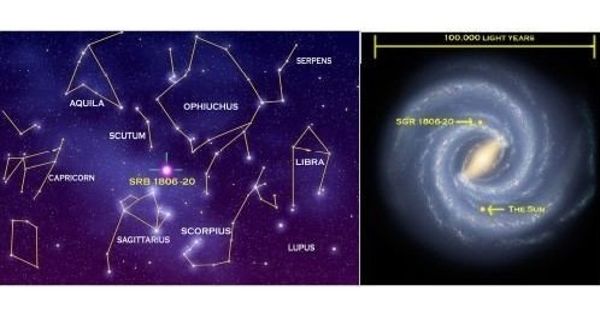Barnard’s Star, also known as Barnard’s Runaway Star, is a very low-mass red dwarf star approximately six light-years away from Earth in the constellation of Ophiuchus (the Snake-holder). It is the fourth-nearest-known individual star to the Sun after the three components of the Alpha Centauri system, and the closest star in the northern celestial hemisphere. It is very old, and moving relatively fast. Despite its proximity, the star has a dim apparent magnitude of +9.5 and is invisible to the unaided eye; it is much brighter in the infrared than in visible light.
In 1916, the American astronomer E. E. Barnard measured its proper motion as 10.3 arcseconds per year. The star is named after the American astronomer E. E. Barnard, who in 1916 measured its proper motion as 10.3 arcseconds per year relative to the Sun, the highest known for any star. This is the largest-known proper motion of any star relative to the Sun. At a distance of about 1.8 parsecs from the Solar System, or just under six light-years, Barnard’s Star is the nearest known star in the constellation Ophiuchus, and the fourth-closest known individual star to the Sun, after the three components of the Alpha Centauri system. The star had previously appeared on Harvard University photographic plates in 1888 and 1890.
Barnard’s star has the largest proper motion of any known star—10.39 seconds of arc annually. It is a red dwarf star with a visual magnitude of 9.5 and thus is too dim to be seen with the naked eye despite its close distance; its intrinsic luminosity is only 1/2,600 that of the Sun.
Despite its proximity, Barnard’s Star, at a dim apparent magnitude of about nine, is not visible with the unaided eye; however, it is much brighter in infrared light than it is in visible light. Barnard’s star came to our attention barely 100 years ago and can’t be seen with the human eye, so the ancients didn’t know about it.

Details
Barnard’s Star has been the subject of much study, and it has probably received more attention from astronomers than any other class M dwarf star due to its proximity and favorable location for observation near the celestial equator. It is among the most studied red dwarfs because of its proximity and favorable location for observation near the celestial equator. Barnard’s Star is also notable as the target for Project Daedalus, a study on the possibility of fast, unmanned travel to nearby star systems.
At seven to 12 billion years of age, Barnard’s Star is considerably older than the Sun, and it might be among the oldest stars in the Milky Way galaxy. At 7–12 billion years of age, Barnard’s Star is considerably older than the Sun, which is 4.5 billion years old, and it might be among the oldest stars in the Milky Way galaxy. Barnard’s Star rotates just once every 130 days (compared with just over 25-30 days for the Sun).
Barnard’s Star presented the first detectable change in the radial velocity of a star caused by its motion. The proper motion of Barnard’s Star is ‘sideways’ relative to our line of sight to the Sun of 90 kilometers per second (km/s). The 10.3 seconds of arc it travels annually amount to a quarter of a degree in a human lifetime, roughly half the angular diameter of the full Moon.
The radial velocity of Barnard’s Star towards the Sun can be measured by its blue shift. These measurements, combined with proper motion, suggest a true velocity relative to the Sun of about 140 km/s. While Barnard’s Star has the largest proper motion, the largest known true velocity of another star in the Milky Way belongs to Wolf 424 at 555 km/s.
Information Source:
















